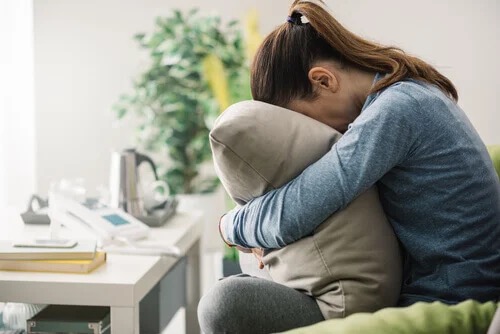Secondary Anxiety: Characteristics and Risks


Written and verified by the psychologist Valeria Sabater
Secondary anxiety is when an anxious person feels that they have no control over themselves. In fact, they live in fear that, at any minute, they might suffer a panic attack and their anxiety will worsen.
However, medical experts say that secondary anxiety may also be defined as the array of contradictory and distressing symptoms that might arise from existing diseases. For example, diseases such as Parkinson’s, fibromyalgia, or cancer often lead to many psychological disorders.
One thing that’s certain is that we can all suffer from anxiety at some point in our lives. In fact, it’s quite normal. It can result from work pressure, relationships, or an inability to deal with stress. But if you deal with these stressors effectively, you won’t suffer from secondary anxiety.
Secondary anxiety occurs when you feel completely overcome. You find yourself unable to deal with your conflicting feelings and emotions. Therefore, anxiety feeds off anxiety and has a significant effect on you.
“You can’t always control what goes on outside. But you can always control what goes on inside.”
-Wayne Dwyer-

The symptoms of secondary anxiety
Some suggest that anxiety is composed of layers of stress superimposed on each other. This is especially common in generalized anxiety disorder (GAD), which makes sufferers worry about everything. In fact, they feel overcome by obligations, experience excessive fears, and have trouble managing their emotions.
Gradually, this mental anxiety becomes embedded in their mentality until, one day, they experience their first panic attack. This experience is usually extremely frightening. In fact, some people even think it’s a heart attack and that they’re going to die. However, when the doctor confirms that this wasn’t the case, the patient moves on to a new stage. They start to suffer secondary anxiety.
These are the most common symptoms:
- People who suffer from secondary anxiety usually ask a lot of themselves. The fact that they suffer anxiety in the first place means they’re already feeling angry with themselves for being unable to control their reality. Therefore, this anxiety leads to more anxiety.
- These people are characterized by feelings of hypervigilance. In other words, they’re constantly on the alert to possible threats around them. Furthermore, they overreact to sounds, smells, and feelings, etc.
- Most of the time, they feel defeated and overcome.

The dangers of secondary anxiety
Albert Ellis created rational emotive behavior therapy (REBT), in which he differentiated between primary and secondary anxiety. The most serious cases of anxiety, like panic disorder and generalized anxiety disorder, occur when a patient gets used to their primary anxiety. Then, they suffer this deeper and more complex form of anxiety.
Nevertheless, if they manage to handle their internal state before it manifests itself as secondary anxiety, they won’t suffer a panic attack. However, what happens when it’s already appeared and the sufferer internalized it?
- Secondary anxiety completely takes away the sufferer’s sense of control over themselves. Furthermore, it entirely undermines their self-esteem and self-confidence.
- At this point, the sufferer can’t think rationally as to how they got to that stage. In fact, they overreact to the anxiety to the extent that they believe there’s no solution. Therefore, they end up adopting rigid psychological approaches.
- Secondary anxiety also forms the basis of other disorders. These might be agoraphobia, major depression, or, in the most severe cases, substance abuse.
How is it treated?
The therapist firstly needs to understand the patient’s individual reality. They’ll make a diagnosis based on their characteristics, context, circumstances, and medical history. Secondly, they might prescribe psychopharmacological treatments alongside broader treatments. This will depend on the patient’s condition.
Therapists usually resort to the following strategies:
- Inform the patient about anxiety. They’ll tell them what it is, what panic attacks are, and give them more information about their own individual diagnosis.
- Detect any maladaptive behaviors that tend to intensify the patient’s anxiety.
- Train the patient in cognitive strategies and techniques to avoid excessive worry, catastrophizing, and automatic thoughts.
- Train the patient in relaxation and breathing techniques.
- Expose the patient to feared situations or stimuli in controlled scenarios.
- Offer strategies for the patient to manage their time and their social skills, plan pleasurable activities, and work towards their goals.
Finally, patients should ideally ask for help before their primary anxiety becomes secondary. This way, they’ll avoid psychological exhaustion, which could lead to latent disorders such as depression. However, with the help of a good professional, sufferers can always learn to cope with the symptoms of this disorder to boost their well-being and regain control over their lives.
Secondary anxiety is when an anxious person feels that they have no control over themselves. In fact, they live in fear that, at any minute, they might suffer a panic attack and their anxiety will worsen.
However, medical experts say that secondary anxiety may also be defined as the array of contradictory and distressing symptoms that might arise from existing diseases. For example, diseases such as Parkinson’s, fibromyalgia, or cancer often lead to many psychological disorders.
One thing that’s certain is that we can all suffer from anxiety at some point in our lives. In fact, it’s quite normal. It can result from work pressure, relationships, or an inability to deal with stress. But if you deal with these stressors effectively, you won’t suffer from secondary anxiety.
Secondary anxiety occurs when you feel completely overcome. You find yourself unable to deal with your conflicting feelings and emotions. Therefore, anxiety feeds off anxiety and has a significant effect on you.
“You can’t always control what goes on outside. But you can always control what goes on inside.”
-Wayne Dwyer-

The symptoms of secondary anxiety
Some suggest that anxiety is composed of layers of stress superimposed on each other. This is especially common in generalized anxiety disorder (GAD), which makes sufferers worry about everything. In fact, they feel overcome by obligations, experience excessive fears, and have trouble managing their emotions.
Gradually, this mental anxiety becomes embedded in their mentality until, one day, they experience their first panic attack. This experience is usually extremely frightening. In fact, some people even think it’s a heart attack and that they’re going to die. However, when the doctor confirms that this wasn’t the case, the patient moves on to a new stage. They start to suffer secondary anxiety.
These are the most common symptoms:
- People who suffer from secondary anxiety usually ask a lot of themselves. The fact that they suffer anxiety in the first place means they’re already feeling angry with themselves for being unable to control their reality. Therefore, this anxiety leads to more anxiety.
- These people are characterized by feelings of hypervigilance. In other words, they’re constantly on the alert to possible threats around them. Furthermore, they overreact to sounds, smells, and feelings, etc.
- Most of the time, they feel defeated and overcome.

The dangers of secondary anxiety
Albert Ellis created rational emotive behavior therapy (REBT), in which he differentiated between primary and secondary anxiety. The most serious cases of anxiety, like panic disorder and generalized anxiety disorder, occur when a patient gets used to their primary anxiety. Then, they suffer this deeper and more complex form of anxiety.
Nevertheless, if they manage to handle their internal state before it manifests itself as secondary anxiety, they won’t suffer a panic attack. However, what happens when it’s already appeared and the sufferer internalized it?
- Secondary anxiety completely takes away the sufferer’s sense of control over themselves. Furthermore, it entirely undermines their self-esteem and self-confidence.
- At this point, the sufferer can’t think rationally as to how they got to that stage. In fact, they overreact to the anxiety to the extent that they believe there’s no solution. Therefore, they end up adopting rigid psychological approaches.
- Secondary anxiety also forms the basis of other disorders. These might be agoraphobia, major depression, or, in the most severe cases, substance abuse.
How is it treated?
The therapist firstly needs to understand the patient’s individual reality. They’ll make a diagnosis based on their characteristics, context, circumstances, and medical history. Secondly, they might prescribe psychopharmacological treatments alongside broader treatments. This will depend on the patient’s condition.
Therapists usually resort to the following strategies:
- Inform the patient about anxiety. They’ll tell them what it is, what panic attacks are, and give them more information about their own individual diagnosis.
- Detect any maladaptive behaviors that tend to intensify the patient’s anxiety.
- Train the patient in cognitive strategies and techniques to avoid excessive worry, catastrophizing, and automatic thoughts.
- Train the patient in relaxation and breathing techniques.
- Expose the patient to feared situations or stimuli in controlled scenarios.
- Offer strategies for the patient to manage their time and their social skills, plan pleasurable activities, and work towards their goals.
Finally, patients should ideally ask for help before their primary anxiety becomes secondary. This way, they’ll avoid psychological exhaustion, which could lead to latent disorders such as depression. However, with the help of a good professional, sufferers can always learn to cope with the symptoms of this disorder to boost their well-being and regain control over their lives.
All cited sources were thoroughly reviewed by our team to ensure their quality, reliability, currency, and validity. The bibliography of this article was considered reliable and of academic or scientific accuracy.
- Rogers, M. P. et. Al. (1999) Comparing primary and secondary generalized anxiety disorder in a long-term naturalistic study of anxiety disorders. Depress Anxiety; 10(1): 1-7.
This text is provided for informational purposes only and does not replace consultation with a professional. If in doubt, consult your specialist.







